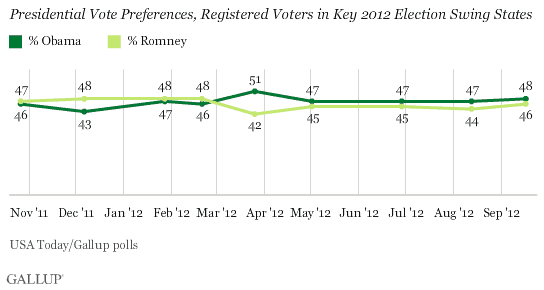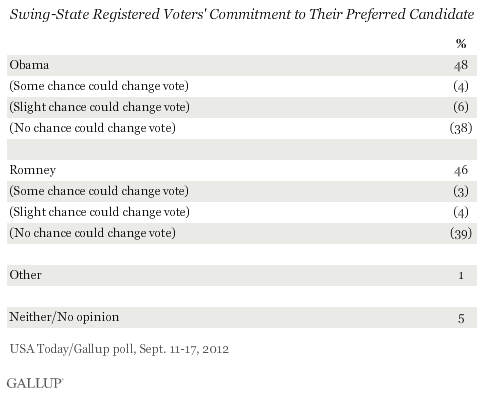PRINCETON, NJ -- Registered voters in key 2012 election swing states remain closely divided in their presidential vote preferences, with 48% supporting President Barack Obama and 46% Mitt Romney. Other than a nine-point lead for Obama in March, the two candidates have been essentially tied in the swing states throughout the campaign.

The results are based on a Sept. 11-17 USA Today/Gallup Swing States poll of 1,096 registered voters in Colorado, Florida, Iowa, Michigan, Nevada, New Hampshire, New Mexico, North Carolina, Ohio, Pennsylvania, Virginia, and Wisconsin.
Gallup Daily tracking of registered voters nationwide now finds Obama at 47% and Romney at 46%, suggesting a fading of Obama's post-convention bounce. At this point, it is too early to tell what impact a newly released video of Romney's unflattering characterization of Obama supporters from an early 2012 fundraising speech might have on the race.
One in Five Swing-State Voters Could Change Minds
Twenty-two percent of swing-state voters are either undecided (5%) or say there is at least a slight chance (17%) they may change their vote preference between now and the election, underscoring the competitiveness of the election and the uncertainty about its ultimate outcome.
That 22% of swing-state voters includes 10% who currently support Obama and 7% who now prefer Romney. The candidates have roughly the same percentage of committed voters -- 39% of Romney supporters and 38% of Obama supporters in the swing states say there is no chance they will change their mind.

Conventions, Debates Not Influencing Most in Swing States
Most swing-state voters, 74%, say the recent political conventions did not have much or any influence on their vote choice. But the one in four swing-state voters who said the conventions did affect their vote -- either a great deal or a fair amount -- are much more likely to be supporting Obama now, by 56% to 41%, providing further evidence that the Democratic convention had a greater impact than the Republican convention.
Three in four swing-state voters also believe the upcoming presidential debates will do little to influence their vote, while 25% say the debates could influence their vote "a great deal" or "a fair amount." While the conventions may have benefited Obama more than Romney, Obama could potentially lose more from the debates with a weak performance because more of those who say the debates could influence their vote currently support Obama rather than Romney, by 54% to 40%.
Implications
Now that more than a week has passed since the Democratic convention and Obama's post-convention bounce is apparently fading, the 2012 presidential election campaign may be reverting to its more competitive equilibrium. Neither candidate appears to have a distinct upper hand among voters in the states whose electoral votes will likely decide the election, as has been the case for most of the campaign.
Obama won all 12 swing states in 2008, giving him a solid Electoral College victory over John McCain, 365 to 173. Romney would need to win roughly two-thirds of the available 151 electoral votes in the swing states to be elected, assuming each candidate wins the solidly Republican or Democratic states each party's nominee won in 2008.
The fact that the swing-state vote is competitive, with at least a slight advantage for Obama each month since March, may mean Obama is currently in a stronger position to win than is Romney. That current advantage could be erased, however, if Republicans vote at higher rates than Democrats, as is usually the case, and if Romney can convince proportionately more undecided and persuadable voters in swing states than Obama can to support his candidacy in the remaining weeks of the campaign.
Track every angle of the presidential race on Gallup.com's Election 2012 page.
Survey Methods
Results for voters in 2012 election swing states are based on telephone interviews conducted Sept. 11-17, 2012, on the Gallup Daily tracking survey, with a random sample of 1,096 registered voters, aged 18 and older, living in Colorado, Florida, Iowa, Michigan, Nevada, New Hampshire, New Mexico, North Carolina, Ohio, Pennsylvania, Virginia, and Wisconsin. The data represent a subset of Gallup's national daily tracking survey for those dates. The swing-state data are weighted to be demographically representative of the combined population in those 12 states.
For results based on the total sample of swing-state registered voters, one can say with 95% confidence that the maximum margin of sampling error is ±4 percentage points.
Interviews are conducted with respondents on landline telephones and cellular phones, with interviews conducted in Spanish for respondents who are primarily Spanish-speaking. Each sample includes a minimum quota of 400 cell phone respondents and 600 landline respondents per 1,000 national adults, with additional minimum quotas among landline respondents by region. Landline telephone numbers are chosen at random among listed telephone numbers. Cell phone numbers are selected using random-digit-dial methods. Landline respondents are chosen at random within each household on the basis of which member had the most recent birthday.
Samples are weighted by gender, age, race, Hispanic ethnicity, education, region, adults in the household, and phone status (cell phone only/landline only/both, cell phone mostly, and having an unlisted landline number). Demographic weighting targets are based on the March 2011 Current Population Survey figures for the aged 18 and older non-institutionalized population living in U.S. telephone households. All reported margins of sampling error include the computed design effects for weighting and sample design.
In addition to sampling error, question wording and practical difficulties in conducting surveys can introduce error or bias into the findings of public opinion polls.
View methodology, full question results, and trend data.
For more details on Gallup's polling methodology, visit www.gallup.com.
